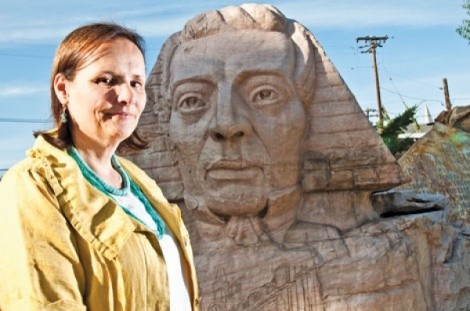
Who created these sculptures?
Thomas Child started at 57 years old [in the mid-1950s], retiring after a lifetime of masonry and raising a family. He was very religious—a 19-year LDS ward bishop—and took those beliefs and engraved them in stone for perpetuity. But, there’s also Sophocles and non-LDS writings. If you take the time reading and try to absorb all the inscriptions, you’ll think he’s a philosopher, expressing himself and making sense in his mind, asking, “What does it all mean?” We all think that. There’s also amazing primitive folk art sculptures that speak on so many levels.
Why are some people turned off by the garden and the sculptures?
Originally, maybe it was spooky because it was closed off. Or, maybe because it is so personal. That’s the problem with visionary art environments: it’s like you’re walking into his head, and if people aren’t comfortable with his thought process, they could be turned off. But, you could step away from that, and interpret art anyway you want. That’s the point, right?
What’s your favorite piece?
It’s kinda weird, but I like “Nebuchadnezzar’s Dream,” especially the head. That’s where the “body parts” are spread across the mound. It reminds me of Easter Island or something.
How did the “secret” Gilgal Garden become a public park?
Before 1999, the Childs sold the property to another family and the garden was too much to manage, so they decided to sell that part. There was a community concern that a developer would purchase it, so Friends of Gilgal wanted to [purchase it] to save it. A lot of people donated individually and funds were raised with tours, but, in the end, we got huge donations from Salt Lake County, the LDS Church and the Eccles Foundation. Once it was purchased, Salt Lake City was willing to accept it as a public park. It’s certainly not your typical park. The county donation stipulated that Friends stay on as curators, maintaining sculptures and doing conservation work. We have a mixture of art-lovers, devout Mormons, business people. It speaks to wide spectrum of people.